Financial Accounting Theory and Research Final Exam Solutions
VerifiedAdded on 2020/04/15
|11
|3567
|47
Homework Assignment
AI Summary
This document provides comprehensive solutions to a final exam in Financial Accounting Theory and Research. The answers address key concepts including the clean surplus theory, the efficient market hypothesis (EMH) with its weak, semi-strong, and strong forms, and the Capital Asset Pricing Model (CAPM). The document explores weaknesses in research methodologies, such as difficulties in establishing cause-and-effect relationships between information and security prices. It also covers the post-earnings announcement drift (PEAD), cross-sectional analysis, the relationship between earning forecasts and investment recommendations, the concept of uniformity in accounting, relevant circumstances, and different approaches to uniformity (finite, rigid, and flexibility). The solutions further examine differential disclosure, Regulation Fair Disclosure, the cost of applying accounting standards for small companies, the Anglo-Saxon and continental models, and the harmonization of accounting standards, including the roles of the IASB and the EU. Finally, the document explores the role of managerial influence in accounting practices.

Running head: FINAL EXAM
Financial accounting theory and research
Financial accounting theory and research
Paraphrase This Document
Need a fresh take? Get an instant paraphrase of this document with our AI Paraphraser
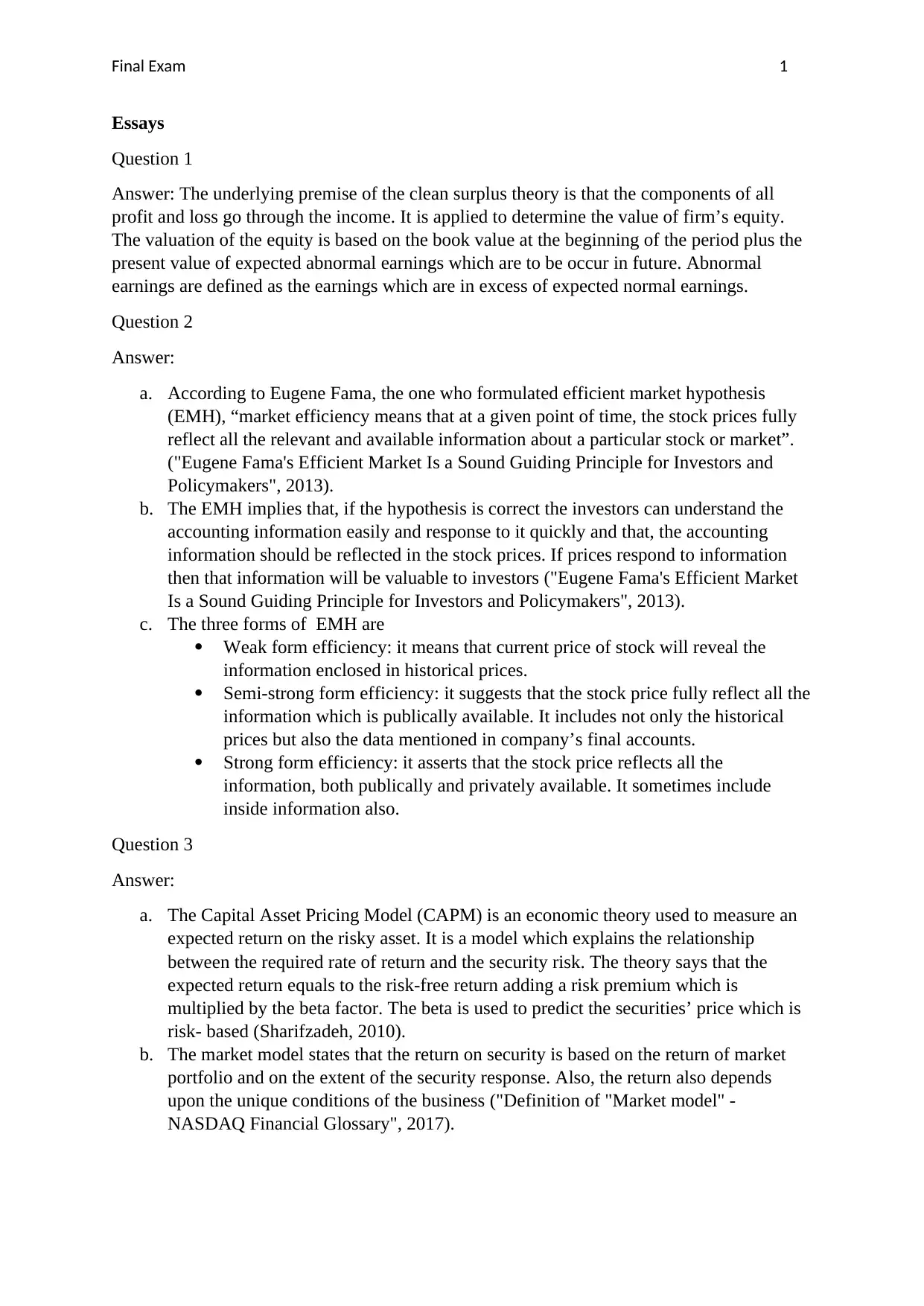
Final Exam 1
Essays
Question 1
Answer: The underlying premise of the clean surplus theory is that the components of all
profit and loss go through the income. It is applied to determine the value of firm’s equity.
The valuation of the equity is based on the book value at the beginning of the period plus the
present value of expected abnormal earnings which are to be occur in future. Abnormal
earnings are defined as the earnings which are in excess of expected normal earnings.
Question 2
Answer:
a. According to Eugene Fama, the one who formulated efficient market hypothesis
(EMH), “market efficiency means that at a given point of time, the stock prices fully
reflect all the relevant and available information about a particular stock or market”.
("Eugene Fama's Efficient Market Is a Sound Guiding Principle for Investors and
Policymakers", 2013).
b. The EMH implies that, if the hypothesis is correct the investors can understand the
accounting information easily and response to it quickly and that, the accounting
information should be reflected in the stock prices. If prices respond to information
then that information will be valuable to investors ("Eugene Fama's Efficient Market
Is a Sound Guiding Principle for Investors and Policymakers", 2013).
c. The three forms of EMH are
Weak form efficiency: it means that current price of stock will reveal the
information enclosed in historical prices.
Semi-strong form efficiency: it suggests that the stock price fully reflect all the
information which is publically available. It includes not only the historical
prices but also the data mentioned in company’s final accounts.
Strong form efficiency: it asserts that the stock price reflects all the
information, both publically and privately available. It sometimes include
inside information also.
Question 3
Answer:
a. The Capital Asset Pricing Model (CAPM) is an economic theory used to measure an
expected return on the risky asset. It is a model which explains the relationship
between the required rate of return and the security risk. The theory says that the
expected return equals to the risk-free return adding a risk premium which is
multiplied by the beta factor. The beta is used to predict the securities’ price which is
risk- based (Sharifzadeh, 2010).
b. The market model states that the return on security is based on the return of market
portfolio and on the extent of the security response. Also, the return also depends
upon the unique conditions of the business ("Definition of "Market model" -
NASDAQ Financial Glossary", 2017).
Essays
Question 1
Answer: The underlying premise of the clean surplus theory is that the components of all
profit and loss go through the income. It is applied to determine the value of firm’s equity.
The valuation of the equity is based on the book value at the beginning of the period plus the
present value of expected abnormal earnings which are to be occur in future. Abnormal
earnings are defined as the earnings which are in excess of expected normal earnings.
Question 2
Answer:
a. According to Eugene Fama, the one who formulated efficient market hypothesis
(EMH), “market efficiency means that at a given point of time, the stock prices fully
reflect all the relevant and available information about a particular stock or market”.
("Eugene Fama's Efficient Market Is a Sound Guiding Principle for Investors and
Policymakers", 2013).
b. The EMH implies that, if the hypothesis is correct the investors can understand the
accounting information easily and response to it quickly and that, the accounting
information should be reflected in the stock prices. If prices respond to information
then that information will be valuable to investors ("Eugene Fama's Efficient Market
Is a Sound Guiding Principle for Investors and Policymakers", 2013).
c. The three forms of EMH are
Weak form efficiency: it means that current price of stock will reveal the
information enclosed in historical prices.
Semi-strong form efficiency: it suggests that the stock price fully reflect all the
information which is publically available. It includes not only the historical
prices but also the data mentioned in company’s final accounts.
Strong form efficiency: it asserts that the stock price reflects all the
information, both publically and privately available. It sometimes include
inside information also.
Question 3
Answer:
a. The Capital Asset Pricing Model (CAPM) is an economic theory used to measure an
expected return on the risky asset. It is a model which explains the relationship
between the required rate of return and the security risk. The theory says that the
expected return equals to the risk-free return adding a risk premium which is
multiplied by the beta factor. The beta is used to predict the securities’ price which is
risk- based (Sharifzadeh, 2010).
b. The market model states that the return on security is based on the return of market
portfolio and on the extent of the security response. Also, the return also depends
upon the unique conditions of the business ("Definition of "Market model" -
NASDAQ Financial Glossary", 2017).
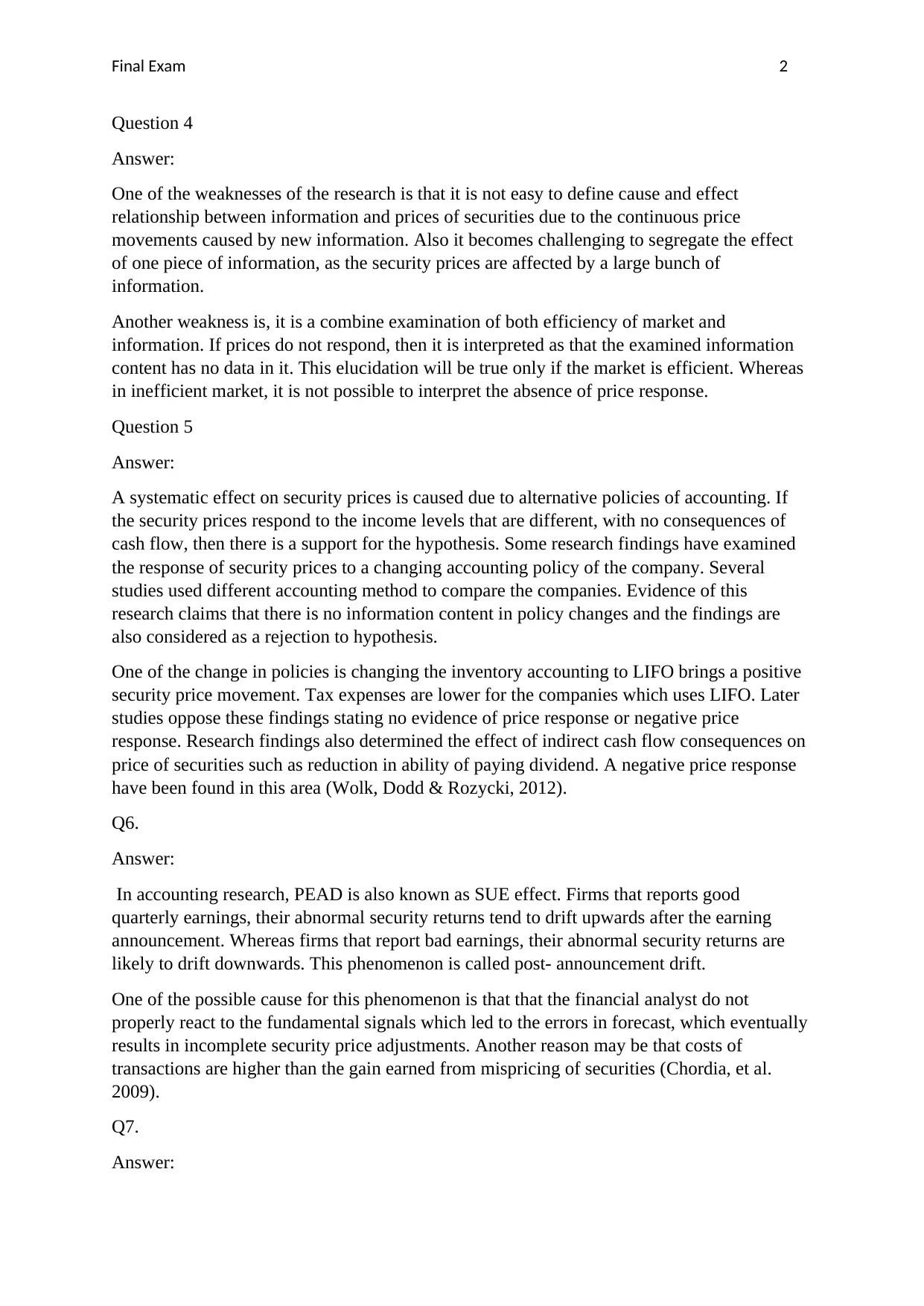
Final Exam 2
Question 4
Answer:
One of the weaknesses of the research is that it is not easy to define cause and effect
relationship between information and prices of securities due to the continuous price
movements caused by new information. Also it becomes challenging to segregate the effect
of one piece of information, as the security prices are affected by a large bunch of
information.
Another weakness is, it is a combine examination of both efficiency of market and
information. If prices do not respond, then it is interpreted as that the examined information
content has no data in it. This elucidation will be true only if the market is efficient. Whereas
in inefficient market, it is not possible to interpret the absence of price response.
Question 5
Answer:
A systematic effect on security prices is caused due to alternative policies of accounting. If
the security prices respond to the income levels that are different, with no consequences of
cash flow, then there is a support for the hypothesis. Some research findings have examined
the response of security prices to a changing accounting policy of the company. Several
studies used different accounting method to compare the companies. Evidence of this
research claims that there is no information content in policy changes and the findings are
also considered as a rejection to hypothesis.
One of the change in policies is changing the inventory accounting to LIFO brings a positive
security price movement. Tax expenses are lower for the companies which uses LIFO. Later
studies oppose these findings stating no evidence of price response or negative price
response. Research findings also determined the effect of indirect cash flow consequences on
price of securities such as reduction in ability of paying dividend. A negative price response
have been found in this area (Wolk, Dodd & Rozycki, 2012).
Q6.
Answer:
In accounting research, PEAD is also known as SUE effect. Firms that reports good
quarterly earnings, their abnormal security returns tend to drift upwards after the earning
announcement. Whereas firms that report bad earnings, their abnormal security returns are
likely to drift downwards. This phenomenon is called post- announcement drift.
One of the possible cause for this phenomenon is that that the financial analyst do not
properly react to the fundamental signals which led to the errors in forecast, which eventually
results in incomplete security price adjustments. Another reason may be that costs of
transactions are higher than the gain earned from mispricing of securities (Chordia, et al.
2009).
Q7.
Answer:
Question 4
Answer:
One of the weaknesses of the research is that it is not easy to define cause and effect
relationship between information and prices of securities due to the continuous price
movements caused by new information. Also it becomes challenging to segregate the effect
of one piece of information, as the security prices are affected by a large bunch of
information.
Another weakness is, it is a combine examination of both efficiency of market and
information. If prices do not respond, then it is interpreted as that the examined information
content has no data in it. This elucidation will be true only if the market is efficient. Whereas
in inefficient market, it is not possible to interpret the absence of price response.
Question 5
Answer:
A systematic effect on security prices is caused due to alternative policies of accounting. If
the security prices respond to the income levels that are different, with no consequences of
cash flow, then there is a support for the hypothesis. Some research findings have examined
the response of security prices to a changing accounting policy of the company. Several
studies used different accounting method to compare the companies. Evidence of this
research claims that there is no information content in policy changes and the findings are
also considered as a rejection to hypothesis.
One of the change in policies is changing the inventory accounting to LIFO brings a positive
security price movement. Tax expenses are lower for the companies which uses LIFO. Later
studies oppose these findings stating no evidence of price response or negative price
response. Research findings also determined the effect of indirect cash flow consequences on
price of securities such as reduction in ability of paying dividend. A negative price response
have been found in this area (Wolk, Dodd & Rozycki, 2012).
Q6.
Answer:
In accounting research, PEAD is also known as SUE effect. Firms that reports good
quarterly earnings, their abnormal security returns tend to drift upwards after the earning
announcement. Whereas firms that report bad earnings, their abnormal security returns are
likely to drift downwards. This phenomenon is called post- announcement drift.
One of the possible cause for this phenomenon is that that the financial analyst do not
properly react to the fundamental signals which led to the errors in forecast, which eventually
results in incomplete security price adjustments. Another reason may be that costs of
transactions are higher than the gain earned from mispricing of securities (Chordia, et al.
2009).
Q7.
Answer:
⊘ This is a preview!⊘
Do you want full access?
Subscribe today to unlock all pages.

Trusted by 1+ million students worldwide
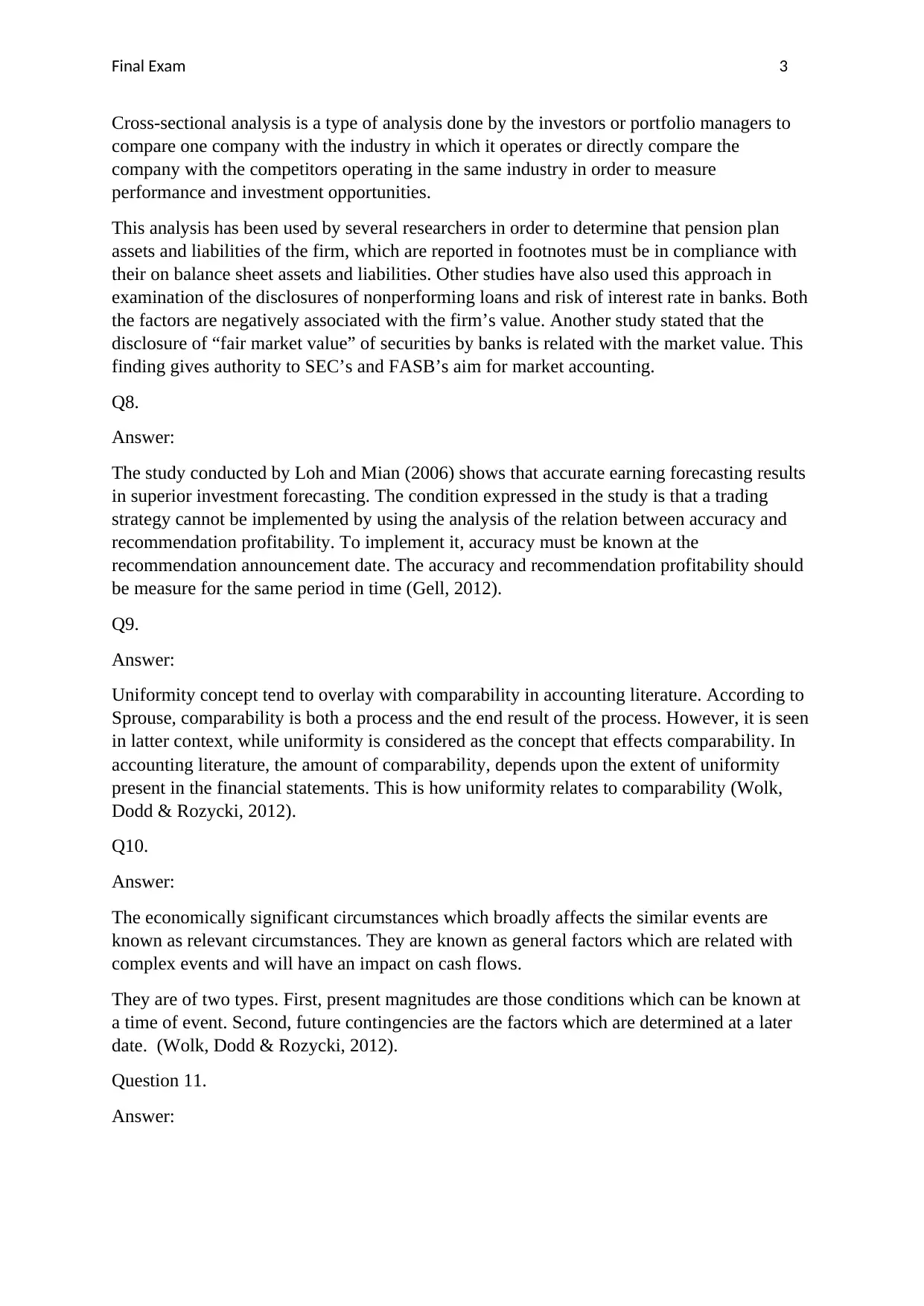
Final Exam 3
Cross-sectional analysis is a type of analysis done by the investors or portfolio managers to
compare one company with the industry in which it operates or directly compare the
company with the competitors operating in the same industry in order to measure
performance and investment opportunities.
This analysis has been used by several researchers in order to determine that pension plan
assets and liabilities of the firm, which are reported in footnotes must be in compliance with
their on balance sheet assets and liabilities. Other studies have also used this approach in
examination of the disclosures of nonperforming loans and risk of interest rate in banks. Both
the factors are negatively associated with the firm’s value. Another study stated that the
disclosure of “fair market value” of securities by banks is related with the market value. This
finding gives authority to SEC’s and FASB’s aim for market accounting.
Q8.
Answer:
The study conducted by Loh and Mian (2006) shows that accurate earning forecasting results
in superior investment forecasting. The condition expressed in the study is that a trading
strategy cannot be implemented by using the analysis of the relation between accuracy and
recommendation profitability. To implement it, accuracy must be known at the
recommendation announcement date. The accuracy and recommendation profitability should
be measure for the same period in time (Gell, 2012).
Q9.
Answer:
Uniformity concept tend to overlay with comparability in accounting literature. According to
Sprouse, comparability is both a process and the end result of the process. However, it is seen
in latter context, while uniformity is considered as the concept that effects comparability. In
accounting literature, the amount of comparability, depends upon the extent of uniformity
present in the financial statements. This is how uniformity relates to comparability (Wolk,
Dodd & Rozycki, 2012).
Q10.
Answer:
The economically significant circumstances which broadly affects the similar events are
known as relevant circumstances. They are known as general factors which are related with
complex events and will have an impact on cash flows.
They are of two types. First, present magnitudes are those conditions which can be known at
a time of event. Second, future contingencies are the factors which are determined at a later
date. (Wolk, Dodd & Rozycki, 2012).
Question 11.
Answer:
Cross-sectional analysis is a type of analysis done by the investors or portfolio managers to
compare one company with the industry in which it operates or directly compare the
company with the competitors operating in the same industry in order to measure
performance and investment opportunities.
This analysis has been used by several researchers in order to determine that pension plan
assets and liabilities of the firm, which are reported in footnotes must be in compliance with
their on balance sheet assets and liabilities. Other studies have also used this approach in
examination of the disclosures of nonperforming loans and risk of interest rate in banks. Both
the factors are negatively associated with the firm’s value. Another study stated that the
disclosure of “fair market value” of securities by banks is related with the market value. This
finding gives authority to SEC’s and FASB’s aim for market accounting.
Q8.
Answer:
The study conducted by Loh and Mian (2006) shows that accurate earning forecasting results
in superior investment forecasting. The condition expressed in the study is that a trading
strategy cannot be implemented by using the analysis of the relation between accuracy and
recommendation profitability. To implement it, accuracy must be known at the
recommendation announcement date. The accuracy and recommendation profitability should
be measure for the same period in time (Gell, 2012).
Q9.
Answer:
Uniformity concept tend to overlay with comparability in accounting literature. According to
Sprouse, comparability is both a process and the end result of the process. However, it is seen
in latter context, while uniformity is considered as the concept that effects comparability. In
accounting literature, the amount of comparability, depends upon the extent of uniformity
present in the financial statements. This is how uniformity relates to comparability (Wolk,
Dodd & Rozycki, 2012).
Q10.
Answer:
The economically significant circumstances which broadly affects the similar events are
known as relevant circumstances. They are known as general factors which are related with
complex events and will have an impact on cash flows.
They are of two types. First, present magnitudes are those conditions which can be known at
a time of event. Second, future contingencies are the factors which are determined at a later
date. (Wolk, Dodd & Rozycki, 2012).
Question 11.
Answer:
Paraphrase This Document
Need a fresh take? Get an instant paraphrase of this document with our AI Paraphraser
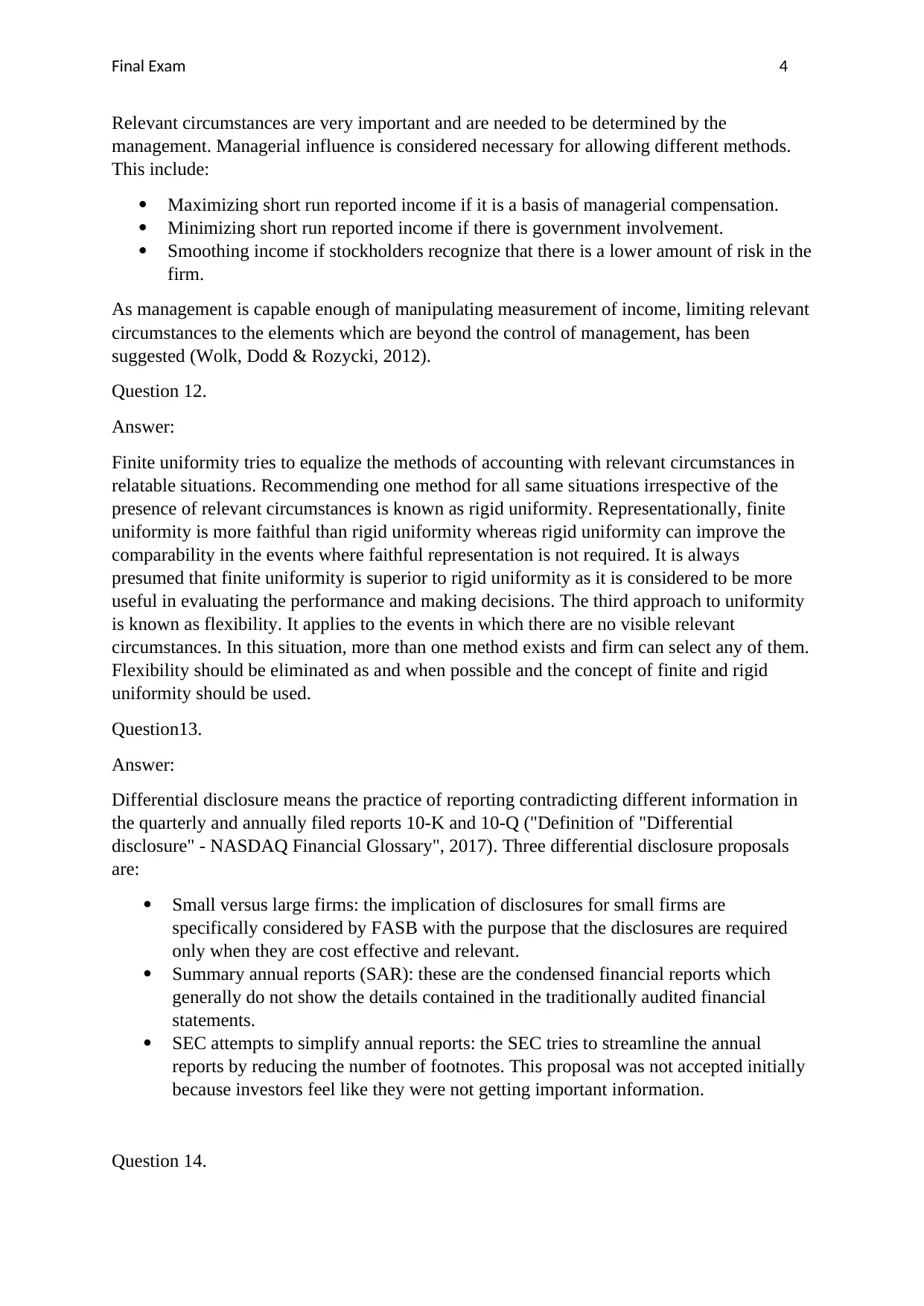
Final Exam 4
Relevant circumstances are very important and are needed to be determined by the
management. Managerial influence is considered necessary for allowing different methods.
This include:
Maximizing short run reported income if it is a basis of managerial compensation.
Minimizing short run reported income if there is government involvement.
Smoothing income if stockholders recognize that there is a lower amount of risk in the
firm.
As management is capable enough of manipulating measurement of income, limiting relevant
circumstances to the elements which are beyond the control of management, has been
suggested (Wolk, Dodd & Rozycki, 2012).
Question 12.
Answer:
Finite uniformity tries to equalize the methods of accounting with relevant circumstances in
relatable situations. Recommending one method for all same situations irrespective of the
presence of relevant circumstances is known as rigid uniformity. Representationally, finite
uniformity is more faithful than rigid uniformity whereas rigid uniformity can improve the
comparability in the events where faithful representation is not required. It is always
presumed that finite uniformity is superior to rigid uniformity as it is considered to be more
useful in evaluating the performance and making decisions. The third approach to uniformity
is known as flexibility. It applies to the events in which there are no visible relevant
circumstances. In this situation, more than one method exists and firm can select any of them.
Flexibility should be eliminated as and when possible and the concept of finite and rigid
uniformity should be used.
Question13.
Answer:
Differential disclosure means the practice of reporting contradicting different information in
the quarterly and annually filed reports 10-K and 10-Q ("Definition of "Differential
disclosure" - NASDAQ Financial Glossary", 2017). Three differential disclosure proposals
are:
Small versus large firms: the implication of disclosures for small firms are
specifically considered by FASB with the purpose that the disclosures are required
only when they are cost effective and relevant.
Summary annual reports (SAR): these are the condensed financial reports which
generally do not show the details contained in the traditionally audited financial
statements.
SEC attempts to simplify annual reports: the SEC tries to streamline the annual
reports by reducing the number of footnotes. This proposal was not accepted initially
because investors feel like they were not getting important information.
Question 14.
Relevant circumstances are very important and are needed to be determined by the
management. Managerial influence is considered necessary for allowing different methods.
This include:
Maximizing short run reported income if it is a basis of managerial compensation.
Minimizing short run reported income if there is government involvement.
Smoothing income if stockholders recognize that there is a lower amount of risk in the
firm.
As management is capable enough of manipulating measurement of income, limiting relevant
circumstances to the elements which are beyond the control of management, has been
suggested (Wolk, Dodd & Rozycki, 2012).
Question 12.
Answer:
Finite uniformity tries to equalize the methods of accounting with relevant circumstances in
relatable situations. Recommending one method for all same situations irrespective of the
presence of relevant circumstances is known as rigid uniformity. Representationally, finite
uniformity is more faithful than rigid uniformity whereas rigid uniformity can improve the
comparability in the events where faithful representation is not required. It is always
presumed that finite uniformity is superior to rigid uniformity as it is considered to be more
useful in evaluating the performance and making decisions. The third approach to uniformity
is known as flexibility. It applies to the events in which there are no visible relevant
circumstances. In this situation, more than one method exists and firm can select any of them.
Flexibility should be eliminated as and when possible and the concept of finite and rigid
uniformity should be used.
Question13.
Answer:
Differential disclosure means the practice of reporting contradicting different information in
the quarterly and annually filed reports 10-K and 10-Q ("Definition of "Differential
disclosure" - NASDAQ Financial Glossary", 2017). Three differential disclosure proposals
are:
Small versus large firms: the implication of disclosures for small firms are
specifically considered by FASB with the purpose that the disclosures are required
only when they are cost effective and relevant.
Summary annual reports (SAR): these are the condensed financial reports which
generally do not show the details contained in the traditionally audited financial
statements.
SEC attempts to simplify annual reports: the SEC tries to streamline the annual
reports by reducing the number of footnotes. This proposal was not accepted initially
because investors feel like they were not getting important information.
Question 14.
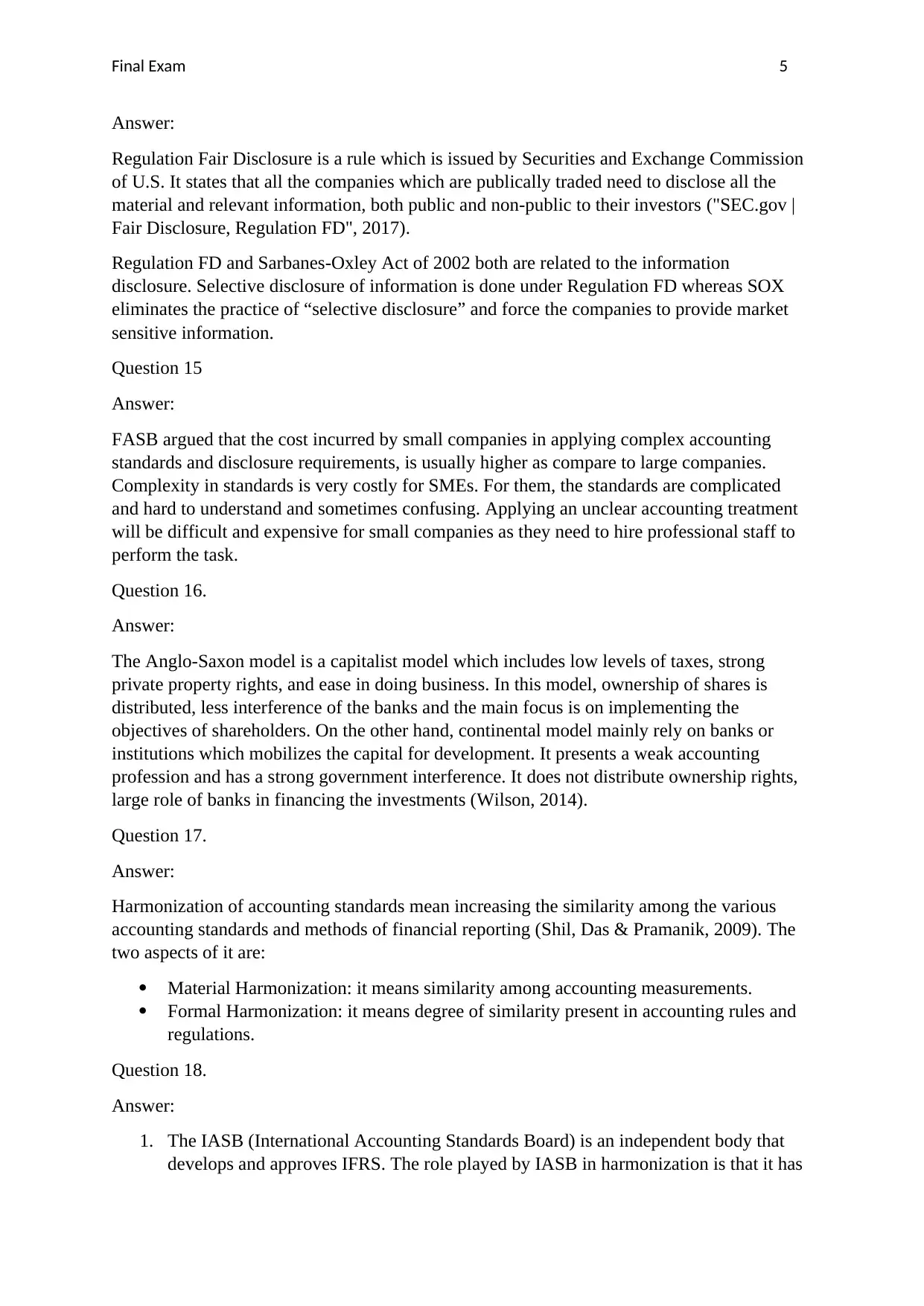
Final Exam 5
Answer:
Regulation Fair Disclosure is a rule which is issued by Securities and Exchange Commission
of U.S. It states that all the companies which are publically traded need to disclose all the
material and relevant information, both public and non-public to their investors ("SEC.gov |
Fair Disclosure, Regulation FD", 2017).
Regulation FD and Sarbanes-Oxley Act of 2002 both are related to the information
disclosure. Selective disclosure of information is done under Regulation FD whereas SOX
eliminates the practice of “selective disclosure” and force the companies to provide market
sensitive information.
Question 15
Answer:
FASB argued that the cost incurred by small companies in applying complex accounting
standards and disclosure requirements, is usually higher as compare to large companies.
Complexity in standards is very costly for SMEs. For them, the standards are complicated
and hard to understand and sometimes confusing. Applying an unclear accounting treatment
will be difficult and expensive for small companies as they need to hire professional staff to
perform the task.
Question 16.
Answer:
The Anglo-Saxon model is a capitalist model which includes low levels of taxes, strong
private property rights, and ease in doing business. In this model, ownership of shares is
distributed, less interference of the banks and the main focus is on implementing the
objectives of shareholders. On the other hand, continental model mainly rely on banks or
institutions which mobilizes the capital for development. It presents a weak accounting
profession and has a strong government interference. It does not distribute ownership rights,
large role of banks in financing the investments (Wilson, 2014).
Question 17.
Answer:
Harmonization of accounting standards mean increasing the similarity among the various
accounting standards and methods of financial reporting (Shil, Das & Pramanik, 2009). The
two aspects of it are:
Material Harmonization: it means similarity among accounting measurements.
Formal Harmonization: it means degree of similarity present in accounting rules and
regulations.
Question 18.
Answer:
1. The IASB (International Accounting Standards Board) is an independent body that
develops and approves IFRS. The role played by IASB in harmonization is that it has
Answer:
Regulation Fair Disclosure is a rule which is issued by Securities and Exchange Commission
of U.S. It states that all the companies which are publically traded need to disclose all the
material and relevant information, both public and non-public to their investors ("SEC.gov |
Fair Disclosure, Regulation FD", 2017).
Regulation FD and Sarbanes-Oxley Act of 2002 both are related to the information
disclosure. Selective disclosure of information is done under Regulation FD whereas SOX
eliminates the practice of “selective disclosure” and force the companies to provide market
sensitive information.
Question 15
Answer:
FASB argued that the cost incurred by small companies in applying complex accounting
standards and disclosure requirements, is usually higher as compare to large companies.
Complexity in standards is very costly for SMEs. For them, the standards are complicated
and hard to understand and sometimes confusing. Applying an unclear accounting treatment
will be difficult and expensive for small companies as they need to hire professional staff to
perform the task.
Question 16.
Answer:
The Anglo-Saxon model is a capitalist model which includes low levels of taxes, strong
private property rights, and ease in doing business. In this model, ownership of shares is
distributed, less interference of the banks and the main focus is on implementing the
objectives of shareholders. On the other hand, continental model mainly rely on banks or
institutions which mobilizes the capital for development. It presents a weak accounting
profession and has a strong government interference. It does not distribute ownership rights,
large role of banks in financing the investments (Wilson, 2014).
Question 17.
Answer:
Harmonization of accounting standards mean increasing the similarity among the various
accounting standards and methods of financial reporting (Shil, Das & Pramanik, 2009). The
two aspects of it are:
Material Harmonization: it means similarity among accounting measurements.
Formal Harmonization: it means degree of similarity present in accounting rules and
regulations.
Question 18.
Answer:
1. The IASB (International Accounting Standards Board) is an independent body that
develops and approves IFRS. The role played by IASB in harmonization is that it has
⊘ This is a preview!⊘
Do you want full access?
Subscribe today to unlock all pages.

Trusted by 1+ million students worldwide
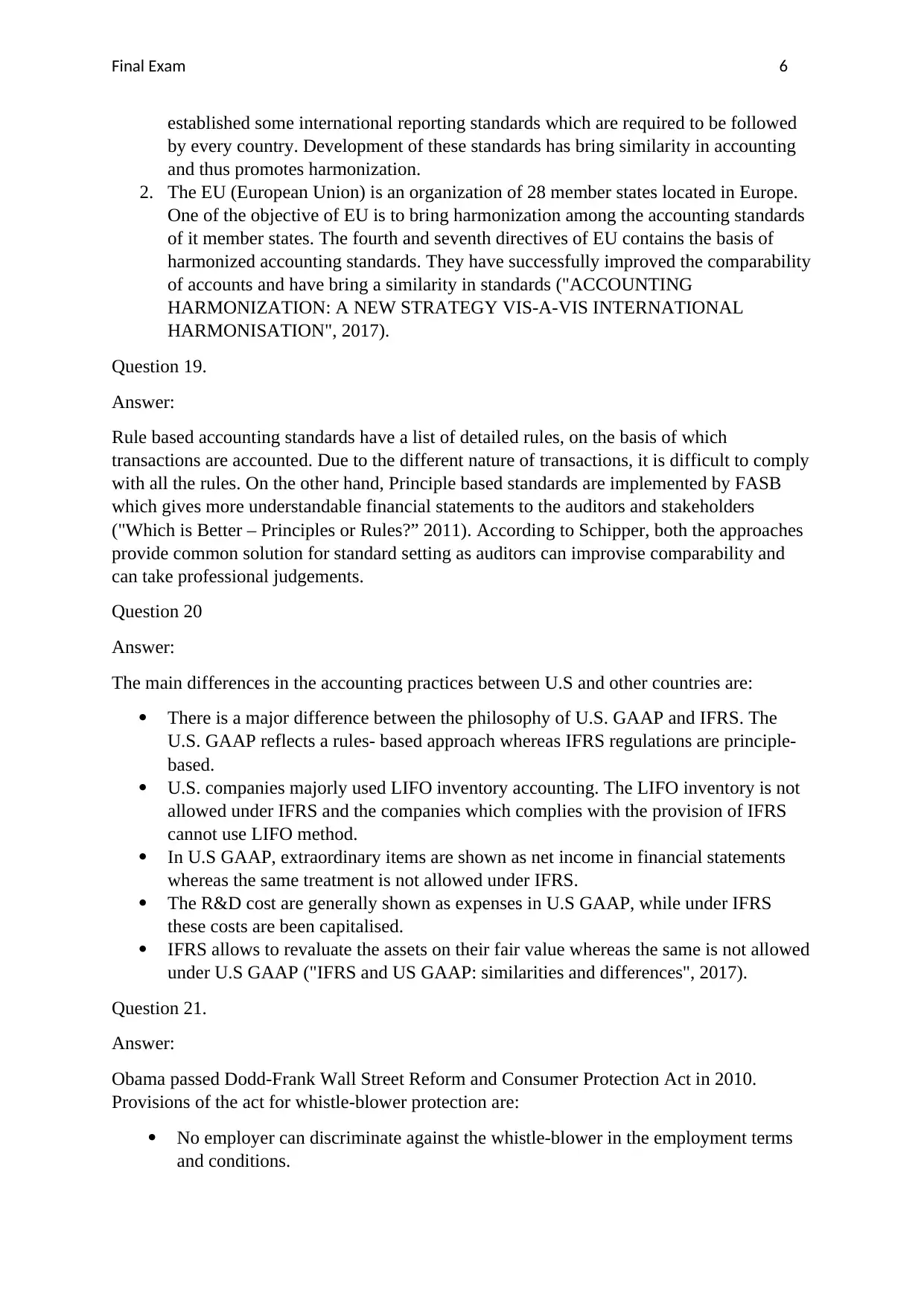
Final Exam 6
established some international reporting standards which are required to be followed
by every country. Development of these standards has bring similarity in accounting
and thus promotes harmonization.
2. The EU (European Union) is an organization of 28 member states located in Europe.
One of the objective of EU is to bring harmonization among the accounting standards
of it member states. The fourth and seventh directives of EU contains the basis of
harmonized accounting standards. They have successfully improved the comparability
of accounts and have bring a similarity in standards ("ACCOUNTING
HARMONIZATION: A NEW STRATEGY VIS-A-VIS INTERNATIONAL
HARMONISATION", 2017).
Question 19.
Answer:
Rule based accounting standards have a list of detailed rules, on the basis of which
transactions are accounted. Due to the different nature of transactions, it is difficult to comply
with all the rules. On the other hand, Principle based standards are implemented by FASB
which gives more understandable financial statements to the auditors and stakeholders
("Which is Better – Principles or Rules?” 2011). According to Schipper, both the approaches
provide common solution for standard setting as auditors can improvise comparability and
can take professional judgements.
Question 20
Answer:
The main differences in the accounting practices between U.S and other countries are:
There is a major difference between the philosophy of U.S. GAAP and IFRS. The
U.S. GAAP reflects a rules- based approach whereas IFRS regulations are principle-
based.
U.S. companies majorly used LIFO inventory accounting. The LIFO inventory is not
allowed under IFRS and the companies which complies with the provision of IFRS
cannot use LIFO method.
In U.S GAAP, extraordinary items are shown as net income in financial statements
whereas the same treatment is not allowed under IFRS.
The R&D cost are generally shown as expenses in U.S GAAP, while under IFRS
these costs are been capitalised.
IFRS allows to revaluate the assets on their fair value whereas the same is not allowed
under U.S GAAP ("IFRS and US GAAP: similarities and differences", 2017).
Question 21.
Answer:
Obama passed Dodd-Frank Wall Street Reform and Consumer Protection Act in 2010.
Provisions of the act for whistle-blower protection are:
No employer can discriminate against the whistle-blower in the employment terms
and conditions.
established some international reporting standards which are required to be followed
by every country. Development of these standards has bring similarity in accounting
and thus promotes harmonization.
2. The EU (European Union) is an organization of 28 member states located in Europe.
One of the objective of EU is to bring harmonization among the accounting standards
of it member states. The fourth and seventh directives of EU contains the basis of
harmonized accounting standards. They have successfully improved the comparability
of accounts and have bring a similarity in standards ("ACCOUNTING
HARMONIZATION: A NEW STRATEGY VIS-A-VIS INTERNATIONAL
HARMONISATION", 2017).
Question 19.
Answer:
Rule based accounting standards have a list of detailed rules, on the basis of which
transactions are accounted. Due to the different nature of transactions, it is difficult to comply
with all the rules. On the other hand, Principle based standards are implemented by FASB
which gives more understandable financial statements to the auditors and stakeholders
("Which is Better – Principles or Rules?” 2011). According to Schipper, both the approaches
provide common solution for standard setting as auditors can improvise comparability and
can take professional judgements.
Question 20
Answer:
The main differences in the accounting practices between U.S and other countries are:
There is a major difference between the philosophy of U.S. GAAP and IFRS. The
U.S. GAAP reflects a rules- based approach whereas IFRS regulations are principle-
based.
U.S. companies majorly used LIFO inventory accounting. The LIFO inventory is not
allowed under IFRS and the companies which complies with the provision of IFRS
cannot use LIFO method.
In U.S GAAP, extraordinary items are shown as net income in financial statements
whereas the same treatment is not allowed under IFRS.
The R&D cost are generally shown as expenses in U.S GAAP, while under IFRS
these costs are been capitalised.
IFRS allows to revaluate the assets on their fair value whereas the same is not allowed
under U.S GAAP ("IFRS and US GAAP: similarities and differences", 2017).
Question 21.
Answer:
Obama passed Dodd-Frank Wall Street Reform and Consumer Protection Act in 2010.
Provisions of the act for whistle-blower protection are:
No employer can discriminate against the whistle-blower in the employment terms
and conditions.
Paraphrase This Document
Need a fresh take? Get an instant paraphrase of this document with our AI Paraphraser
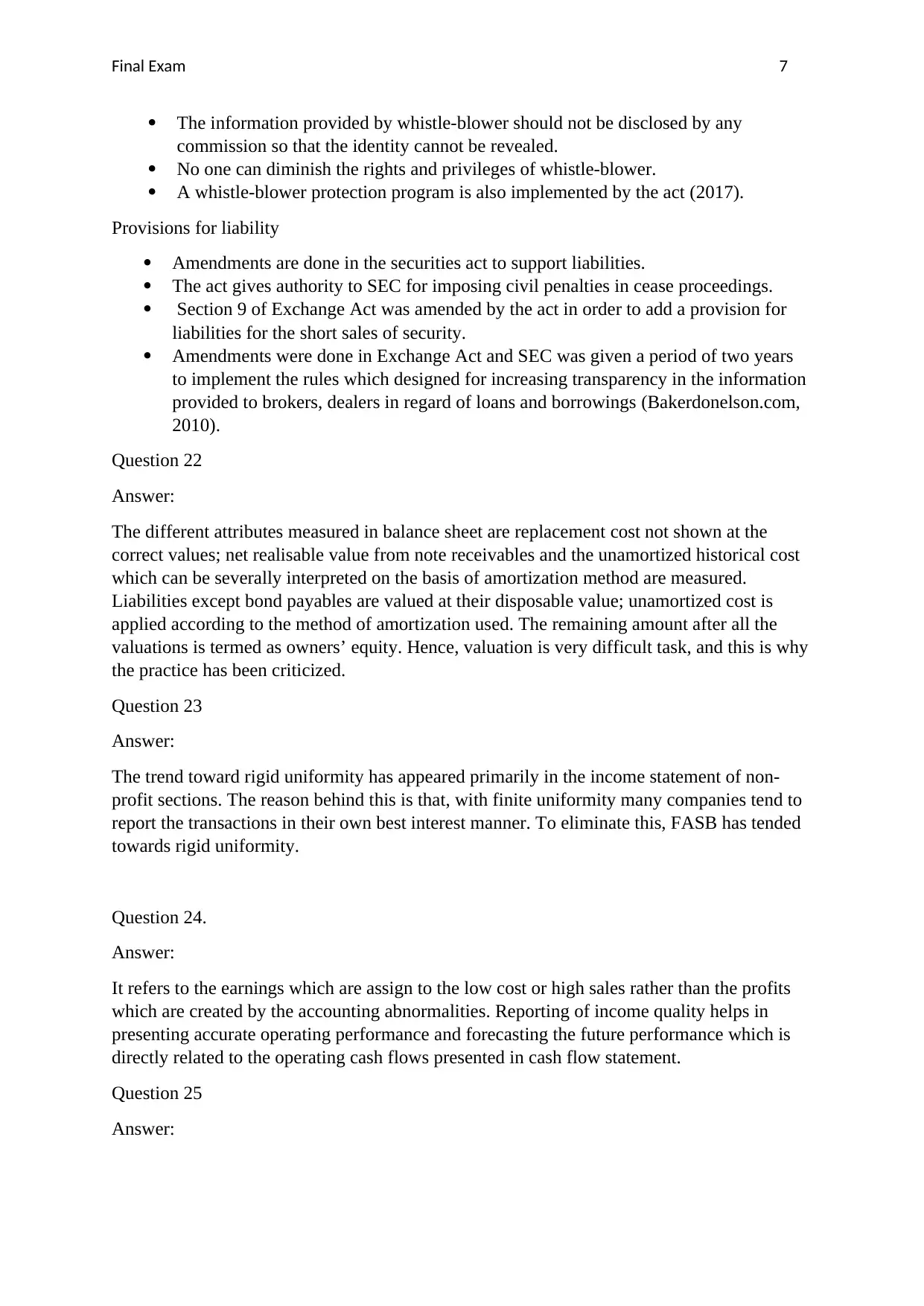
Final Exam 7
The information provided by whistle-blower should not be disclosed by any
commission so that the identity cannot be revealed.
No one can diminish the rights and privileges of whistle-blower.
A whistle-blower protection program is also implemented by the act (2017).
Provisions for liability
Amendments are done in the securities act to support liabilities.
The act gives authority to SEC for imposing civil penalties in cease proceedings.
Section 9 of Exchange Act was amended by the act in order to add a provision for
liabilities for the short sales of security.
Amendments were done in Exchange Act and SEC was given a period of two years
to implement the rules which designed for increasing transparency in the information
provided to brokers, dealers in regard of loans and borrowings (Bakerdonelson.com,
2010).
Question 22
Answer:
The different attributes measured in balance sheet are replacement cost not shown at the
correct values; net realisable value from note receivables and the unamortized historical cost
which can be severally interpreted on the basis of amortization method are measured.
Liabilities except bond payables are valued at their disposable value; unamortized cost is
applied according to the method of amortization used. The remaining amount after all the
valuations is termed as owners’ equity. Hence, valuation is very difficult task, and this is why
the practice has been criticized.
Question 23
Answer:
The trend toward rigid uniformity has appeared primarily in the income statement of non-
profit sections. The reason behind this is that, with finite uniformity many companies tend to
report the transactions in their own best interest manner. To eliminate this, FASB has tended
towards rigid uniformity.
Question 24.
Answer:
It refers to the earnings which are assign to the low cost or high sales rather than the profits
which are created by the accounting abnormalities. Reporting of income quality helps in
presenting accurate operating performance and forecasting the future performance which is
directly related to the operating cash flows presented in cash flow statement.
Question 25
Answer:
The information provided by whistle-blower should not be disclosed by any
commission so that the identity cannot be revealed.
No one can diminish the rights and privileges of whistle-blower.
A whistle-blower protection program is also implemented by the act (2017).
Provisions for liability
Amendments are done in the securities act to support liabilities.
The act gives authority to SEC for imposing civil penalties in cease proceedings.
Section 9 of Exchange Act was amended by the act in order to add a provision for
liabilities for the short sales of security.
Amendments were done in Exchange Act and SEC was given a period of two years
to implement the rules which designed for increasing transparency in the information
provided to brokers, dealers in regard of loans and borrowings (Bakerdonelson.com,
2010).
Question 22
Answer:
The different attributes measured in balance sheet are replacement cost not shown at the
correct values; net realisable value from note receivables and the unamortized historical cost
which can be severally interpreted on the basis of amortization method are measured.
Liabilities except bond payables are valued at their disposable value; unamortized cost is
applied according to the method of amortization used. The remaining amount after all the
valuations is termed as owners’ equity. Hence, valuation is very difficult task, and this is why
the practice has been criticized.
Question 23
Answer:
The trend toward rigid uniformity has appeared primarily in the income statement of non-
profit sections. The reason behind this is that, with finite uniformity many companies tend to
report the transactions in their own best interest manner. To eliminate this, FASB has tended
towards rigid uniformity.
Question 24.
Answer:
It refers to the earnings which are assign to the low cost or high sales rather than the profits
which are created by the accounting abnormalities. Reporting of income quality helps in
presenting accurate operating performance and forecasting the future performance which is
directly related to the operating cash flows presented in cash flow statement.
Question 25
Answer:

Final Exam 8
In SFAS 157, transaction costs are not related to the use of assets and liabilities. They
specific to a particular transaction and varies on the basis of reporting of transactions. The
accounts represented by transaction costs are different from the accounts for assets and
liabilities valued at fair value. So yes it is true that these cost do not play any role in
determining the best use of assets and liabilities ("Statement of Financial Accounting
Standards No. 157", 2017).
Question 26
Answer:
According to GAAP, every company needs to disclose the pension information. Instead of
disclosing in other reports, the company should show its Defined Benefit Plan in its financial
statements. If company does not do the same, it will violates the standards of GAAP and will
not present a fair picture of its financial position.
In SFAS 157, transaction costs are not related to the use of assets and liabilities. They
specific to a particular transaction and varies on the basis of reporting of transactions. The
accounts represented by transaction costs are different from the accounts for assets and
liabilities valued at fair value. So yes it is true that these cost do not play any role in
determining the best use of assets and liabilities ("Statement of Financial Accounting
Standards No. 157", 2017).
Question 26
Answer:
According to GAAP, every company needs to disclose the pension information. Instead of
disclosing in other reports, the company should show its Defined Benefit Plan in its financial
statements. If company does not do the same, it will violates the standards of GAAP and will
not present a fair picture of its financial position.
⊘ This is a preview!⊘
Do you want full access?
Subscribe today to unlock all pages.

Trusted by 1+ million students worldwide
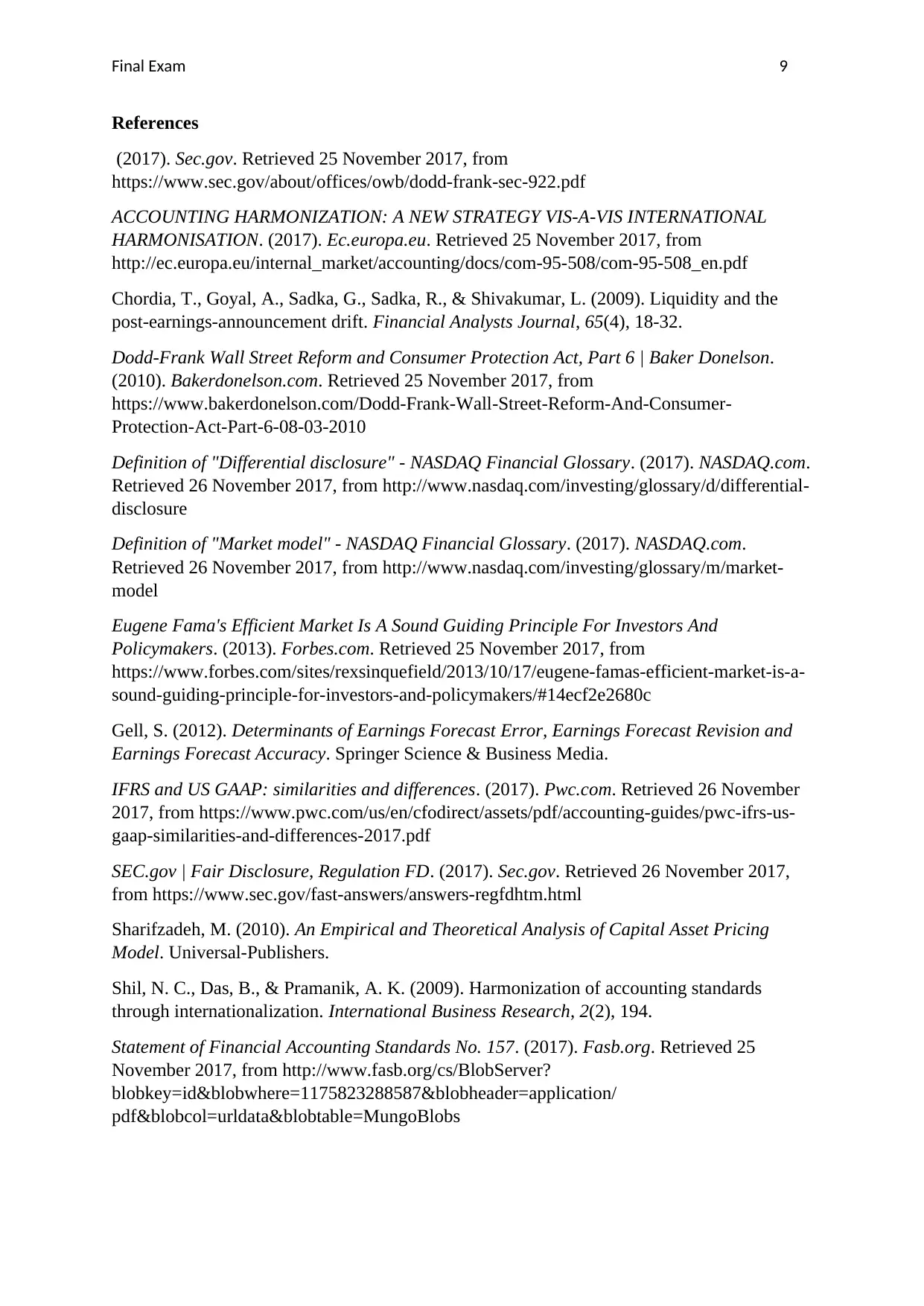
Final Exam 9
References
(2017). Sec.gov. Retrieved 25 November 2017, from
https://www.sec.gov/about/offices/owb/dodd-frank-sec-922.pdf
ACCOUNTING HARMONIZATION: A NEW STRATEGY VIS-A-VIS INTERNATIONAL
HARMONISATION. (2017). Ec.europa.eu. Retrieved 25 November 2017, from
http://ec.europa.eu/internal_market/accounting/docs/com-95-508/com-95-508_en.pdf
Chordia, T., Goyal, A., Sadka, G., Sadka, R., & Shivakumar, L. (2009). Liquidity and the
post-earnings-announcement drift. Financial Analysts Journal, 65(4), 18-32.
Dodd-Frank Wall Street Reform and Consumer Protection Act, Part 6 | Baker Donelson.
(2010). Bakerdonelson.com. Retrieved 25 November 2017, from
https://www.bakerdonelson.com/Dodd-Frank-Wall-Street-Reform-And-Consumer-
Protection-Act-Part-6-08-03-2010
Definition of "Differential disclosure" - NASDAQ Financial Glossary. (2017). NASDAQ.com.
Retrieved 26 November 2017, from http://www.nasdaq.com/investing/glossary/d/differential-
disclosure
Definition of "Market model" - NASDAQ Financial Glossary. (2017). NASDAQ.com.
Retrieved 26 November 2017, from http://www.nasdaq.com/investing/glossary/m/market-
model
Eugene Fama's Efficient Market Is A Sound Guiding Principle For Investors And
Policymakers. (2013). Forbes.com. Retrieved 25 November 2017, from
https://www.forbes.com/sites/rexsinquefield/2013/10/17/eugene-famas-efficient-market-is-a-
sound-guiding-principle-for-investors-and-policymakers/#14ecf2e2680c
Gell, S. (2012). Determinants of Earnings Forecast Error, Earnings Forecast Revision and
Earnings Forecast Accuracy. Springer Science & Business Media.
IFRS and US GAAP: similarities and differences. (2017). Pwc.com. Retrieved 26 November
2017, from https://www.pwc.com/us/en/cfodirect/assets/pdf/accounting-guides/pwc-ifrs-us-
gaap-similarities-and-differences-2017.pdf
SEC.gov | Fair Disclosure, Regulation FD. (2017). Sec.gov. Retrieved 26 November 2017,
from https://www.sec.gov/fast-answers/answers-regfdhtm.html
Sharifzadeh, M. (2010). An Empirical and Theoretical Analysis of Capital Asset Pricing
Model. Universal-Publishers.
Shil, N. C., Das, B., & Pramanik, A. K. (2009). Harmonization of accounting standards
through internationalization. International Business Research, 2(2), 194.
Statement of Financial Accounting Standards No. 157. (2017). Fasb.org. Retrieved 25
November 2017, from http://www.fasb.org/cs/BlobServer?
blobkey=id&blobwhere=1175823288587&blobheader=application/
pdf&blobcol=urldata&blobtable=MungoBlobs
References
(2017). Sec.gov. Retrieved 25 November 2017, from
https://www.sec.gov/about/offices/owb/dodd-frank-sec-922.pdf
ACCOUNTING HARMONIZATION: A NEW STRATEGY VIS-A-VIS INTERNATIONAL
HARMONISATION. (2017). Ec.europa.eu. Retrieved 25 November 2017, from
http://ec.europa.eu/internal_market/accounting/docs/com-95-508/com-95-508_en.pdf
Chordia, T., Goyal, A., Sadka, G., Sadka, R., & Shivakumar, L. (2009). Liquidity and the
post-earnings-announcement drift. Financial Analysts Journal, 65(4), 18-32.
Dodd-Frank Wall Street Reform and Consumer Protection Act, Part 6 | Baker Donelson.
(2010). Bakerdonelson.com. Retrieved 25 November 2017, from
https://www.bakerdonelson.com/Dodd-Frank-Wall-Street-Reform-And-Consumer-
Protection-Act-Part-6-08-03-2010
Definition of "Differential disclosure" - NASDAQ Financial Glossary. (2017). NASDAQ.com.
Retrieved 26 November 2017, from http://www.nasdaq.com/investing/glossary/d/differential-
disclosure
Definition of "Market model" - NASDAQ Financial Glossary. (2017). NASDAQ.com.
Retrieved 26 November 2017, from http://www.nasdaq.com/investing/glossary/m/market-
model
Eugene Fama's Efficient Market Is A Sound Guiding Principle For Investors And
Policymakers. (2013). Forbes.com. Retrieved 25 November 2017, from
https://www.forbes.com/sites/rexsinquefield/2013/10/17/eugene-famas-efficient-market-is-a-
sound-guiding-principle-for-investors-and-policymakers/#14ecf2e2680c
Gell, S. (2012). Determinants of Earnings Forecast Error, Earnings Forecast Revision and
Earnings Forecast Accuracy. Springer Science & Business Media.
IFRS and US GAAP: similarities and differences. (2017). Pwc.com. Retrieved 26 November
2017, from https://www.pwc.com/us/en/cfodirect/assets/pdf/accounting-guides/pwc-ifrs-us-
gaap-similarities-and-differences-2017.pdf
SEC.gov | Fair Disclosure, Regulation FD. (2017). Sec.gov. Retrieved 26 November 2017,
from https://www.sec.gov/fast-answers/answers-regfdhtm.html
Sharifzadeh, M. (2010). An Empirical and Theoretical Analysis of Capital Asset Pricing
Model. Universal-Publishers.
Shil, N. C., Das, B., & Pramanik, A. K. (2009). Harmonization of accounting standards
through internationalization. International Business Research, 2(2), 194.
Statement of Financial Accounting Standards No. 157. (2017). Fasb.org. Retrieved 25
November 2017, from http://www.fasb.org/cs/BlobServer?
blobkey=id&blobwhere=1175823288587&blobheader=application/
pdf&blobcol=urldata&blobtable=MungoBlobs
Paraphrase This Document
Need a fresh take? Get an instant paraphrase of this document with our AI Paraphraser
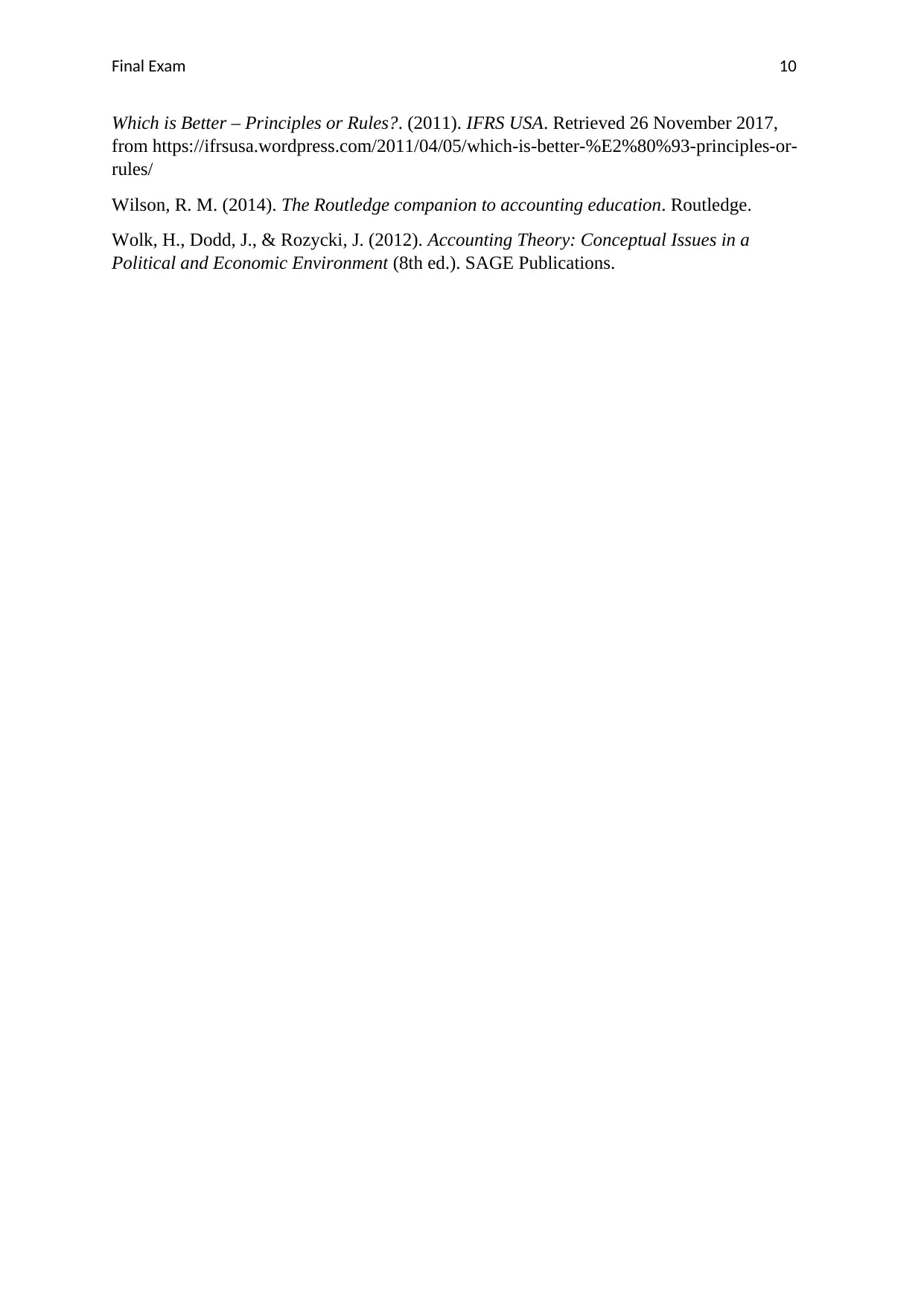
Final Exam 10
Which is Better – Principles or Rules?. (2011). IFRS USA. Retrieved 26 November 2017,
from https://ifrsusa.wordpress.com/2011/04/05/which-is-better-%E2%80%93-principles-or-
rules/
Wilson, R. M. (2014). The Routledge companion to accounting education. Routledge.
Wolk, H., Dodd, J., & Rozycki, J. (2012). Accounting Theory: Conceptual Issues in a
Political and Economic Environment (8th ed.). SAGE Publications.
Which is Better – Principles or Rules?. (2011). IFRS USA. Retrieved 26 November 2017,
from https://ifrsusa.wordpress.com/2011/04/05/which-is-better-%E2%80%93-principles-or-
rules/
Wilson, R. M. (2014). The Routledge companion to accounting education. Routledge.
Wolk, H., Dodd, J., & Rozycki, J. (2012). Accounting Theory: Conceptual Issues in a
Political and Economic Environment (8th ed.). SAGE Publications.
1 out of 11
Related Documents
Your All-in-One AI-Powered Toolkit for Academic Success.
+13062052269
info@desklib.com
Available 24*7 on WhatsApp / Email
![[object Object]](/_next/static/media/star-bottom.7253800d.svg)
Unlock your academic potential
Copyright © 2020–2025 A2Z Services. All Rights Reserved. Developed and managed by ZUCOL.





